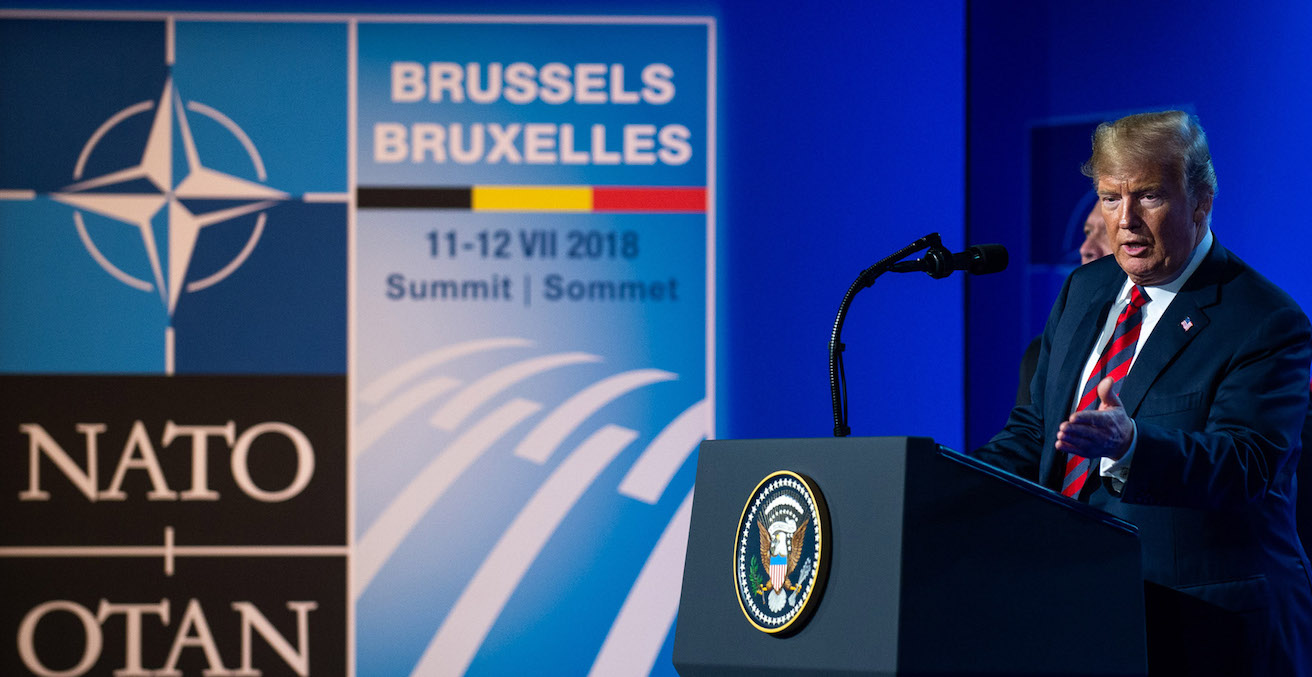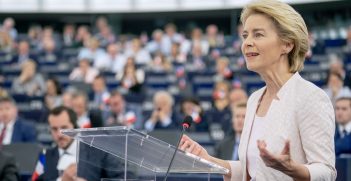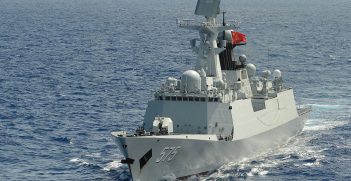Missing the Mark: NATO’s Brussels Blunder

After comparing last week’s NATO Summit to its 2016 predecessor in Warsaw, it is evident the alliance has shifted from a focus on adaptation, readiness and responsiveness to a preoccupation with Russia.
The transatlantic relationship has emerged more or less intact from the Trump factor at the recent Brussels Summit. The traditionally frank forum was conducive to President Trump’s mode of operation and it would seem that fears of alliance fracture were largely over exaggerated. NATO is still intact and has the Brussels Summit Declaration to prove it, with the two key themes expected to take centre stage – what to do about Russia and who was going to pay for it – doing just that. NATO came down hard on an increasingly resurgent Russia, whilst also stating loud and clear that it had bolstered its commitment to sharing the burden of costs.
Unfortunately, NATO has ushered in a short-sighted approach to dealing with security challenges. Gone is the former interest, enshrined in the pre-Trump 2016 NATO Declaration on Transnational Security, to address a range of challenges. This shift is the real threat to the alliance and may ensure NATO is unable to adapt to the realities of the emerging strategic environment.
Instead of focusing on the traditional “arc of instability” along NATO’s 360 degree border, as enshrined by previous Summit declarations, the Brussels Declaration focuses heavily on only the security of the rules-based global order. Brussels’ predecessor communique, from the pre-Trump 2016 Warsaw Summit, frames the security environment rather differently. This is despite the central components of Russia’s assault on the rules-based global order – aggression toward Ukraine since 2014 and the annexation of Crimea – having occurred prior to the Warsaw Summit as well.
Despite the continuity in the environment since 2016, there are a number of divergences in the Warsaw and Brussels communiques. The Warsaw Summit communique touches briefly on the “vital transatlantic bond” and the essential mission of NATO as a “community” of freedom, peace and security. The Warsaw communique examined the global terrorist threat and got around to Russia by paragraph 9, whereas the Brussels communique called out Russia’s “aggressive actions” in paragraph 2 and continued to do so until paragraph 10. The preoccupation with Russia continued throughout the communique.
The Brussels Summit condemned Moscow for undermining Euro-Atlantic security and made allegations of interference in the 2016 US election. Further, the declaration noted it was “highly likely” that Russia was responsible for the nerve agent attack in the United Kingdom earlier this year. Brussels also called out Russia’s territorial aggression toward Ukraine, Georgia and Moldova as well as Moscow’s military presence within each of the states. Then, flipping a switch, the declaration moved to make a plea for a “meaningful dialogue” with Russia.
Where the Warsaw Summit discussed a range of threats from the East and South, the Brussels Summit shows a short-sighted focus on Russia. This points to a broader issue within the alliance: situational awareness. Basic geography puts the North Atlantic space well within NATO’s sphere of strategic interest. And yet, recent Summit communiques fail to recognise the magnitude of the strategic threat from the North. Crucially, NATO has failed to cultivate situational awareness, intelligence, surveillance and reconnaissance capabilities in the North Atlantic, specifically in the GIUK Gap (the ocean area between Greenland, Iceland and the United Kingdom). NATO’s naval focus on the Mediterranean region has meant Russian A2/AD strategy in the North Atlantic is rather entrenched. It is sound policymaking to understand the Russian threat in its complex form, for the alliance to be across all facets of the hybrid foreign policy of the Kremlin. The North Atlantic factors into Russian strategy as much as its cyber methodology does and yet the alliance is failing to grasp the hybrid nature of Putin’s Russia.
The Brussels Summit reiterated the role of NATO to project stability beyond its borders. It continued to hold Russia accountable for breaking “trust” and for the numerous failed attempts to build a partnership. It is apparent the NATO lacks understanding of what drives Russia. Within the Russian “black box” are a range of strategies the Kremlin employs to achieve what Russia wants: international respect, recognition of her great power and a new polycentric world order in which Russia and the US are equal. Much if not all of Russian foreign policy under Putin can be arranged quite comfortably under these three themes. None of these strategies are conducive to NATO strategy and vice versa.
Moscow has accepted this reality while NATO has not. The Brussels Summit builds upon the Warsaw Summit’s misstep of putting Ukraine at the top of a NATO-Russia agenda. Areas of potential cooperation should come before this big-ticket item, as it is one on which Moscow will never budge. The Crimean Peninsula was raised in both communiques, as was a reminder that the alliance does not and “will not” recognise Russia’s territorial claim. We should not expect any movement from the Kremlin on this either.
In terms of output, the Brussels Summit delivered on holding Russia to account for increasingly assertive, at times aggressive, actions in the global arena. Despite being one third shorter than the Warsaw Summit communique, the Brussels Declaration still managed to refer to Russia some 56 times to Warsaw’s 60. The Brussels Summit also dealt firmly with Trump’s calls for the alliance to work harder at sharing the costs of transatlantic security. The Brussels communique affirmed NATO commitment to “fair burden sharing” fairly early on in the piece. Yet, this sentiment was nothing new. NATO was already focusing on burden sharing as the Warsaw Summit communique highlighted. It was in 2016 that NATO members’ collective defence expenditure increased for the first time since 2009. Indeed, the 2016 Warsaw communique stressed NATO’s ongoing efforts to achieve a “more balanced sharing of costs”.
Strategically, the Brussels communique placed the transatlantic security front and centre, unmissable for Trump. The indispensable nature of the alliance was spelt out in rather simple terms and yet there was also a reduction in the sentiment that NATO was entirely reliant on the US. The Brussels Summit made a point of the mutually beneficial nature of the US-NATO marriage. The 2016 Warsaw Summit served, at least for allies, as an opportunity for NATO to claw back credibility across its deterrence and defence capabilities. The alliance has achieved some of the Warsaw objectives, but not all.
Perhaps the greatest stumble of all for the Brussels Summit was the relegation of energy security challenges to the back end of the document. Management of this unifying long-term strategic threat was instead delegated back to the states themselves. NATO used the Brussels Summit to reiterate the primacy of national governments in ensuring energy security. Despite Trump’s apparent issue with Germany’s Nord Stream 2 project with Russia, NATO’s Secretary General reiterated the alliance’s stance on matters of energy security that any decisions to do with the future of Nord Stream 2 were “not for NATO to decide”.
After conducting a stocktake of the recent NATO Summit and comparing it to its predecessor in Warsaw, it is evident the alliance has shifted from a focus on adaptation, readiness and responsiveness to a preoccupation with Russia. Ultimately, this will hold NATO back from effectively reshaping itself in the changing global security architecture.
Dr Elizabeth Buchanan is a research fellow with the Centre for European Studies at the Australian National University and was previously a Visiting Fellow with the NATO Defense College. She received an Early Career Research Impact Award from the Australian Institute of International Affairs in 2018. The views expressed in this publication are the author’s own.
This article is published under a Creative Commons Licence and may be republished with attribution.





